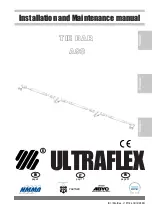
5
AODDAMPENER™
AODDampener Model
AOD-10 (1”)
AOD-15 (1.5”)
AOD-20 (2”)
AOD-30 (3”)
PTFE Diaphragm Kit
AOD-10-100
AOD-15-100
AOD-20-100
AOD-30-100
PTFE Diaphragm Kit, ATEX
AOD-10-100-AT
AOD-15-100-AT
AOD-20-100-AT
AOD-30-100-AT
O-Ring Installation Tool
AD10-032
AD00-032
AD00-032
AD30-032
Replacement Kits and Tools
Diaphragm replacement kits include all parts necessary for replacement, including hardware and O-rings. The O-Ring Installation Tool
is intended solely for use when installing O-rings in the automatic valve on the non-wetted housing of the AODDampener to ensure
proper O-ring placement on reassembly.
Regularly inspect compressed air line for damage. If compressed air to dampener is reduced or stopped, diaphragm failure will
occur.
DO NOT use dampener if the fasteners (nuts and bolts) are corroded. Check for fastener corrosion frequently, especially in
atmospheres containing salt or corrosive chemicals, or if dampener leakage has occurred.
Read Before Installation
Maintenance and Repair
Figure 1
Prior to starting the pump,
dampener must have the air supply connected and available to the dampener to avoid possible damage to
diaphragms. Once the air supply connection is complete, the dampener is fully functional and will operate automatically when the pump
is started.
To avoid damage to diaphragms, DO NOT start the pump before compressed air is supplied to dampener.
Step 3 — Startup
If a diaphragm failure occurs, it is possible for the pumped product to enter the dampener air chamber and be expelled from
the dampener exhaust. It is recommended that the exhaust be plumbed to a safe area or to a Blacoh SPILLSTOP
™
unit if the
dampener location and/or the nature of the pumped product presents a hazard.
If a diaphragm failure occurs, it is possible for the pumped product to enter the dampener air chamber and into the
compressed air line. It is recommended that a one-way check valve be installed at the air connection to prevent backflow of
product.
The exhaust port in the automatic valve is supplied with a muffler. Dampener will not operate if the exhaust port is blocked or, if
an air supply is attached to that port.
Pump must be turned off and system pressure must be zero prior to dampener disassembly. In systems with a static
head pressure, it is not sufficient to simply isolate the dampener. To prevent damage to the PTFE diaphragm, fluid system
pressure must be relieved prior to removing charge pressure from dampener.
Diaphragm Replacement
Disassembly
1. Turn pump off and allow system pressure to drop to zero pressure. Disconnect compressed air line to dampener.






























